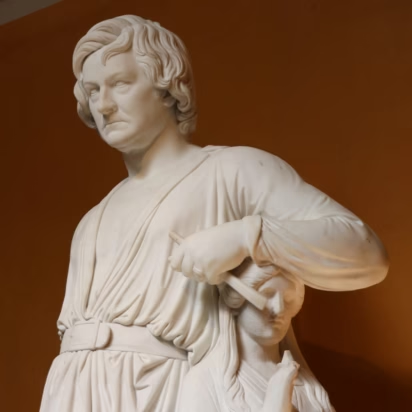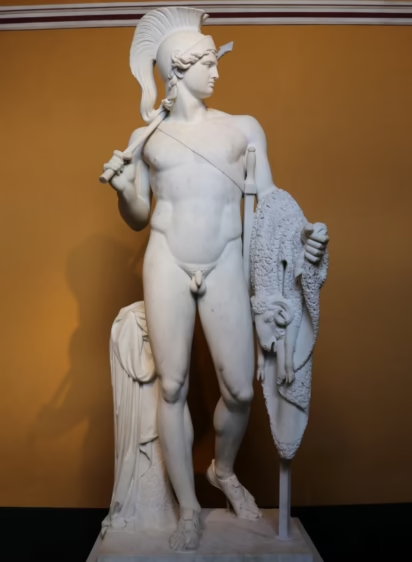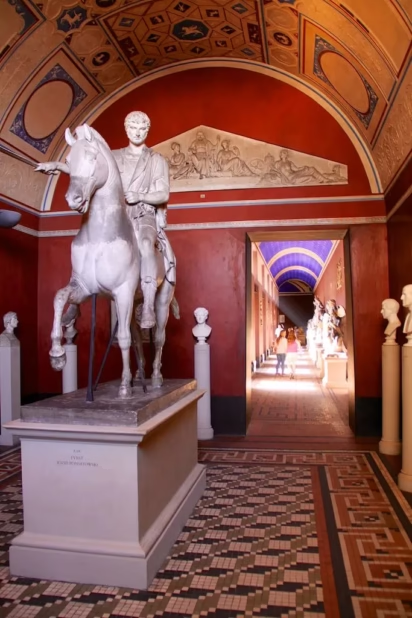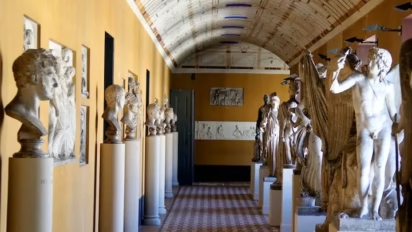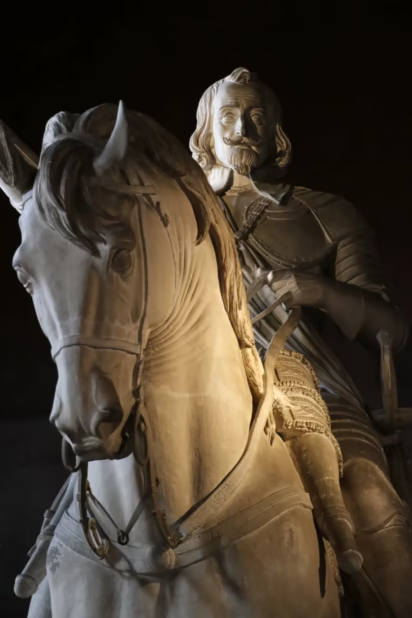Visit the Thorvaldsens Museum in Copenhagen to see the complete collection of the sculptures and art gallery of the Danish classical sculptor Bertel Thorvaldsen.
The purpose-built Thorvaldsens Museum is a gallery to display sculptures, copies, models, and sketches of all the works produced by Bertel Thorvaldsen, as well as his own collection of art, antiquities, and coins. Although inspired by Greek architecture, the museum has unique Pompeian-style painted ceilings and wall decoration to best show the classical sculptures and artist’s clay models. Admission is free on Wednesdays.
Bertel Thorvaldsen (1770 – 1844)
Karl Albert Bertel Thorvaldsen (1770 – 1844) was a Danish artist, who arguably was the most famous sculptor of his age. Although from a poor background, scholarships allowed him to train in the Royal Danish Academy of Art at age 11 and to travel on a stipend to Rome in 1797.
He was due to return to Denmark in 1803, as his money ran out, but with his crates already packed, Thorvaldsen sold a statue of Jason to the wealthy English patron Thomas Hope. He, fortunately, took cash in advance, as the actual marble statue was only completed 25 years later. (He finished other works for Hope in the meantime — including busts of Thomas and his wife that are displayed in the same room as the marble Jason.)
During the first half of the 19th century, Thorvaldsen developed to the foremost sculptor of neo-Classical sculptures in Europe. Antonio Canova praised his work and after Canova’s death in 1822, Thorvaldsen was the undisputed master of the genre.
Thorvaldsen kept to the classic ideals while producing sculptures of kings and nobles, historic and religious figures, as well as Greek mythology. His works can be seen all over Europe with some works also popular in the USA. He is the only non-Italian sculptor with a work in St Peter’s Basilica in the Vatican (Monument for Pope Pius VII).
Thorvaldsen returned to Copenhagen in 1838 as a national hero. He brought with him many items from his workshop including the models for all his sculptures. These models, as well as his personal art collection, were donated to Denmark and are displayed in the museum he helped design himself. He died shortly after the completion of the design of the building in 1844 (although the museum itself could only open four years later).
Thorvaldsens Museum of Sculptures in Copenhagen
The Thorvaldsens Museum on Slotsholmen Island next to the Christiansborg palace complex in central Copenhagen was purposely designed to house the collective works of Bertel Thorvaldsen. The museum is worth visiting not only for Thorvaldsen’s sculptures but also for the architecture, the beautiful decorations, the clever display techniques, and the personal art collection of Thorvaldsen.
The Thorvaldsens Museum was designed by Michael Gottlieb Bindesbøll with the help of Thorvaldsen himself with the sole purpose to exhibit the lifework of Thorvaldsen. The building was inspired by Greek architecture but also has strong Egyptian and Pompeian influences. Each room in the museum has unique ceiling decorations (some by Christen Købke) and wall colors selected to enhance the impact of the works on display.
The exterior is painted with a large series of paintings showing the triumphal return of Thorvaldsen to Copenhagen with his sculptures and workshop from Rome. The bronze Quadriga with Victory over the main entrance was made by HV Bissen but designed by Thorvaldsen himself.
Sculpture Exhibitions in the Thorvaldsens Museum

The displays in the Thorvaldsens Museum are spread over three floors:
The Main Floor
The Main Floor (ground floor) of the Thorvaldsens Museum has the most important works in the collection. The Grand Hall has plaster copies of some of the monumental works of Thorvaldsen that are now in various European capitals.
The magnificent marble statues and reliefs are displayed in the 20 gallery rooms that are on the outside of the corridors. Here each room has its own wall, floor, and ceiling decorations – often inspired by Pompeian designs – to show off the white marble works of Thorvaldsen to best effect.
The Christ Gallery – on the opposite end of the museum from the Grand Hall – has the models for the statues of Christ and the Apostles that are now in marble in the Copenhagen Cathedral (Vor Frue Domkirke).
Thorvaldsens grave is at the center of the courtyard that is surrounded by corridors with his plaster models.
→ See also Sculptures of Ganymede in the Thorvaldsens Museum.
The Upper Floor
The main exhibition on the upper floor of the museum is of Thorvaldsen’s vast collection of antiquities and paintings.
Thorvaldsen’s artifacts from antiquity are an eclectic collection of works from ancient Greece, Egypt, Etruscan, and Rome. The display is largely unaltered from what it looked like at the time of the museum’s opening. A delight for visitors who prefer items stacked high rather than dumbed down in a less-is-more fashion.
The Memorial Room is furnished, as Thorvaldsen’s professorial residence was in the Academy of Arts. His collection of Danish Golden Age and other European paintings are on display in the galleries on the northern side of the building.
As on the ground floor, original plaster models of Thorvaldsen’s work are on display in the corridors on the upper floor.
Lower Floor
The lower floor is mostly used for temporary exhibitions. The small permanent exhibition on this floor contains personal items of Thorvaldsen, early works, and an explanation of the process followed from clay model to plaster cast and finally carved marble.
The master rarely picked up a chisel himself. However, some works on display in the museum, including Ganymede with Jupiter’s Eagle, are believed to have been carved by Thorvaldsen himself.
Visitor Information for the Thorvaldsens Museum
Admission Tickets
Admission to the Thorvaldsens Museum is DKK90 for adults, free for children under 18. The museum is free on Wednesday.
The ticket currently gives admission also to the Museum of Copenhagen and usually the Nikolaj Kunsthal as well (within 48 hours).
The Copenhagen Card is accepted.
Audio guides are available for free in a range of languages.
Free wifi is available in the Grand Hall area. Only drinks and very small snacks are available in the courtyard area.
Opening Hours
The Thorvaldsens Museum is open Tuesday to Sunday from 10 am to 5 pm, closing at 9 pm on Thursdays. The museum is closed on Mondays, December 24, 25, 31, and January 1.
Location of the Thorvaldsens Museum
The Thorvaldsens Museum is at 2 Bertel Thorvaldsens Plads, 1213 Copenhagen K, tel. +45 33 32 15 32. This is on Slotholmen Island next to the Christiansborg palace complex in central Copenhagen. The Strombroen, Nationalmuseet bus stop is directly in front of the museum and served by major bus lines including 2A, 23, 31, and 37 but many may find the Gammel Strand metro stop (M3 red and M4 blue) more useful.
Other Sites in the Vicinity
- All the sights on Slotholmen Island, including the Christiansborg palace complex with free viewing platform (via elevator rather than stairs).
- National Museum of Denmark – the top history museum in Copenhagen.
- Museum of Copenhagen — the small city history museum.
- Ny Carlsberg Glyptotek — largest antiquities collection in Scandinavia and a large collection of 19th-century Danish and French art (paintings and sculptures).
More Art in Copenhagen
- National Gallery of Denmark (Statens Museum for Kunst / SMK) – the largest collection of Danish and Nordic paintings in the world
- Ny Carlsberg Glyptoteket – 19th-century Danish and French art (paintings and sculptures)
- Royal Cast Collection (rarely open these days)
- Design Museum of Denmark
- Louisiana Museum of Modern Art to the north of Copenhagen
- Arken Museum of Modern Art to the southwest of Copenhagen
- Ordrupgaard Museum in the northern suburbs with mostly impressionist art

